The Secret Life of Food: How Your Lunch Affects the Planet
- Students
- April 4, 2025
- Viva Education
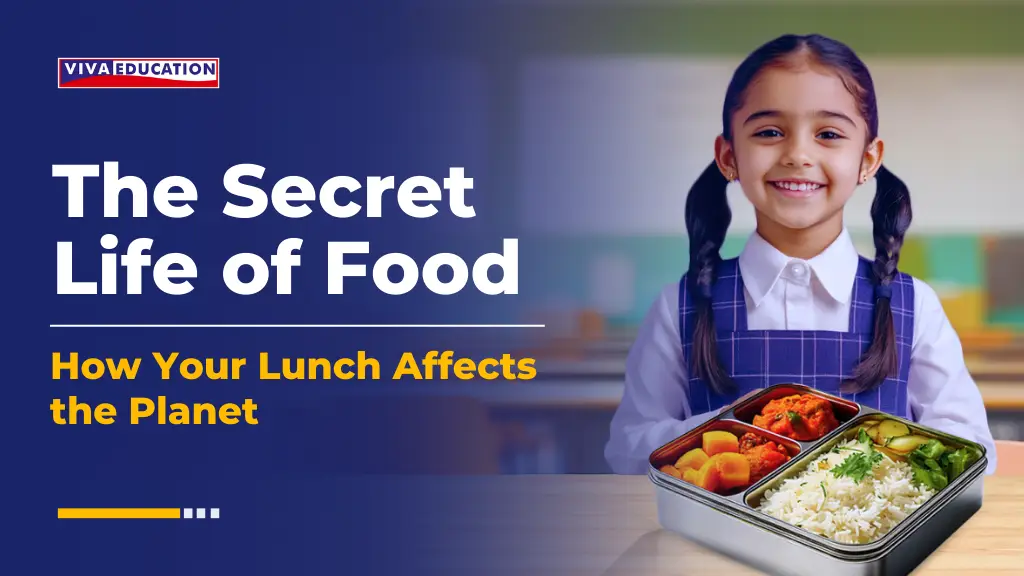
Have you ever thought about where your food comes from before it reaches your plate? That chapati, rice, or packet of chips in your lunchbox has traveled a long way from farms to factories, onto trucks, and finally to your home or school. Along the way, a huge amount of water is used, pollution is created, and a lot of waste is left behind without us even noticing.
The food we eat impacts the environment more than we realise. Growing crops, raising animals, and transporting food require water, fuel, and energy, all of which affect nature. Plus, the plastic packaging from biscuits, chocolates, and snacks often ends up in landfills or streets, making things worse. But the good news is, small changes in the way we eat can help protect our planet.
Let’s look closely at how our food choices affect the environment and how we can improve them.
The Hidden Journey of Your Meal
India is one of the world’s largest food producers, supplying everything from grains and vegetables to spices and dairy. But before food, whether fresh fruits from a local market or a packed snack from a supermarket, it goes through a long journey before reaching your lunch box.
This journey happens in four key stages:
- Farming: Farming is where food is grown or raised. Crops like wheat, rice, and pulses are cultivated, while animals are reared for milk, eggs, and meat. Food quality depends on farming practices, climate conditions, and resource use.
- Processing: Some foods are eaten fresh, but others go through processing to make them ready for sale. This can be as simple as cleaning and drying grains or as complex as making biscuits, instant noodles, or ready-to-eat meals. Processing helps improve taste, texture, and shelf life.
- Transportation: Once food is harvested or processed, it must be transported. Grains from Punjab, mangoes from Maharashtra, and spices from Kerala travel across states and countries. Trucks, trains, ships, or aeroplanes make this movement to reach local markets and stores.
- Packaging: To keep food fresh and safe, it is packed in different materials like plastic, glass, paper, or metal. Packaging helps in easy storage and transportation, preventing food from getting spoiled before it reaches consumers.
But here’s the catch: every stage of food production affects the environment, but some cause more damage than others. Processed foods, in particular, have a much more significant impact than fresh, natural foods. Why? Because they go through extra steps like refining, adding preservatives, and using a lot of plastic for packaging.
For example, a standard potato chip packet demands potato farming followed by oil extraction with industrial procedures and plastic packaging combined with international shipping, which results in increased carbon emissions. The research found that the emissions from a potato chip bag reach 75 grams of CO₂, equivalent to half a kilometre of car travel.
Although, making homemade meals from locally sourced ingredients reduces waste and minimises plastic consumption while reducing the processing energy needs to a significant extent. By choosing local and natural ingredients, you avoid all the extra steps processed foods go through, like factory machines, trucks burning fuel to travel long distances, cold storage using electricity, and tons of plastic packaging.
The True Cost of Food: Water, Carbon, and Waste
1. Water Footprint: The Invisible Drain
We often don’t realize it, but producing the food we eat requires a significant amount of water. Water footprint is the total amount of freshwater used to produce the goods and services we consume. It includes all the water used in production, from growing crops to manufacturing products.
- 1 egg = 200 liters
- 1 loaf of bread = 650 liters
- 1 kg of rice = 2,500 liters
- 1 bar of chocolate = 1,700 liters
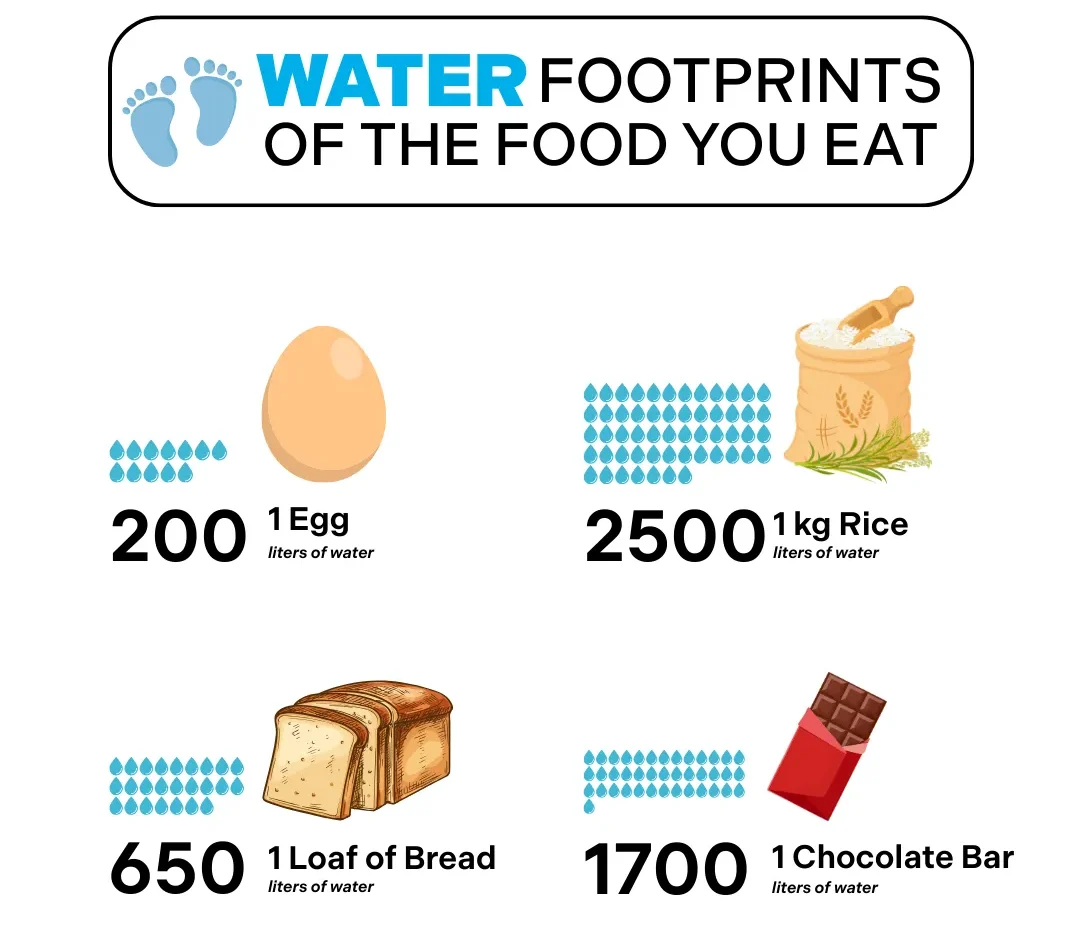
Especially when we remember that 785 million people worldwide don’t have clean drinking water.
In fact, the water used to make just one burger could give someone drinking water for 2.5 years!
2. Carbon Footprint
When humans engage in activities like burning fossil fuels, running factories, and farming, they release carbon dioxide (CO₂) into the atmosphere. This CO₂ acts like a blanket, trapping heat from the sun and causing the Earth’s temperature to rise, a phenomenon known as the greenhouse effect. Food production contributes significantly to these emissions due to farming methods, transportation, and processing. Different foods have varying carbon footprints:
- 1 kg Vegetables = 0.5 kg CO₂
- 1 kg Chicken = 6 kg CO₂
- 1 kg Cheese = 13.5 kg CO₂
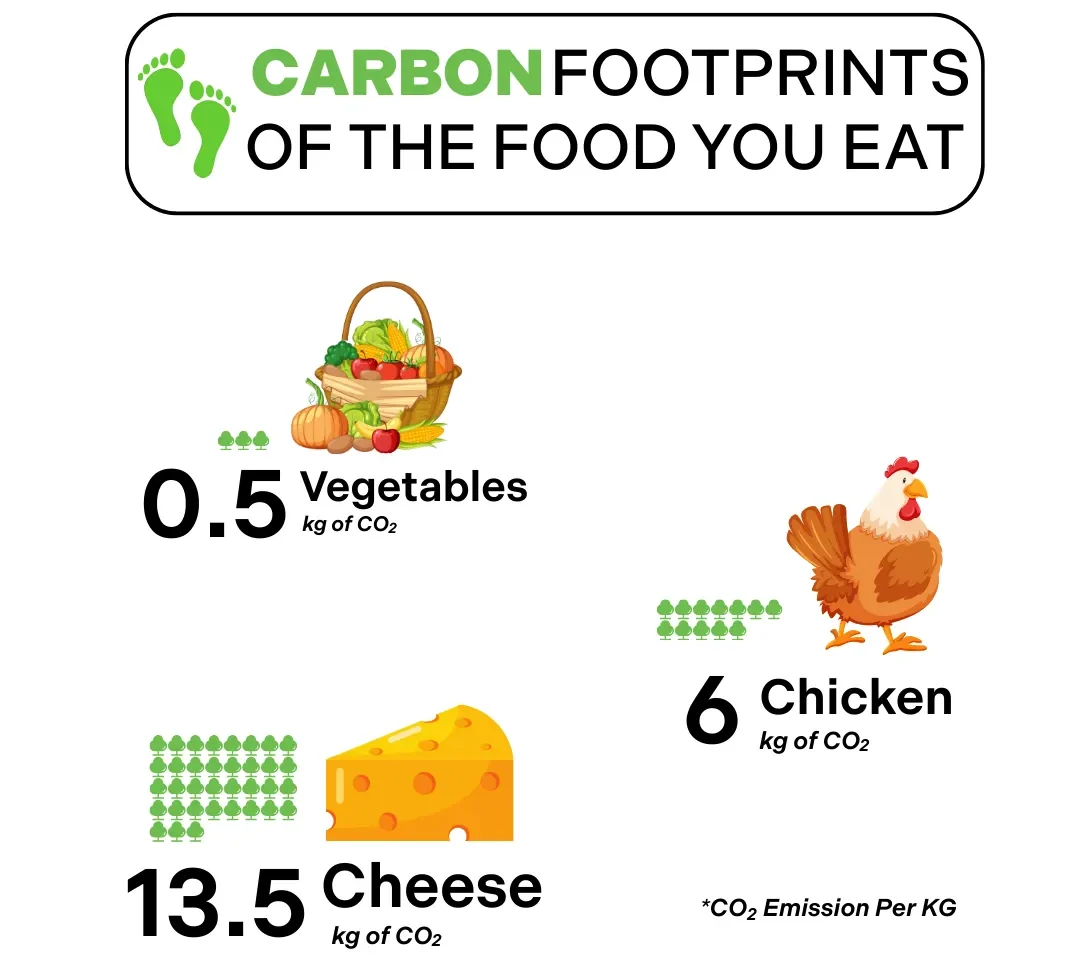
Research shows that switching to plant-based eating for a single weekly day helps society avoid 16 million car emissions each year.
3. Food Waste
Food and Agriculture Organization (FAO) research shows that nations waste one-third of their annual 1.3 billion tons of food production. In India, 190 million people experience hunger daily because the nation dismisses 40% of its food supplies.
- Indian households generate about 50 kg of food waste per person annually, totaling approximately 68.8 million tonnes nationwide.
- When you discard a single burger that was not eaten, you waste the amount of water needed to take a 90-minute shower.
- Every apple in the landfill creates unnecessary methane harmful to the environment, at 25 times the strength of CO₂.
To address this issue, it is essential to implement mindful consumption practices and support food redistribution initiatives. Below are several strategies to help mitigate these impacts.
How You Can Make a Difference
The good news? Make simple, conscious decisions to achieve meaningful results. Here’s how:
1. Smart Swaps for a Sustainable Lunch
- Eating local products from seasonal sources helps decrease delivery costs through smaller distances.
- You should buy fresh ingredients instead of processed ones because they reduce power usage and plastic waste.
- Using reusable containers helps us avoid plastic waste in the environment.
- Eating foods from the lower levels of the food chain means consuming fewer meat products and more plant-based foods.
2. The 100-Metre Meal: Growing Your Food
A tiny balcony space enables the growth of herbs, greens, and tomatoes.
- Students across Japan and Denmark participate in food cultivation initiatives at their schools, promoting sustainable practices and environmental education.
- A rooftop farm based in New York City cultivates 50,000 pounds of vegetables per year, simultaneously lowering transport pollution and reducing urban heat temperatures.
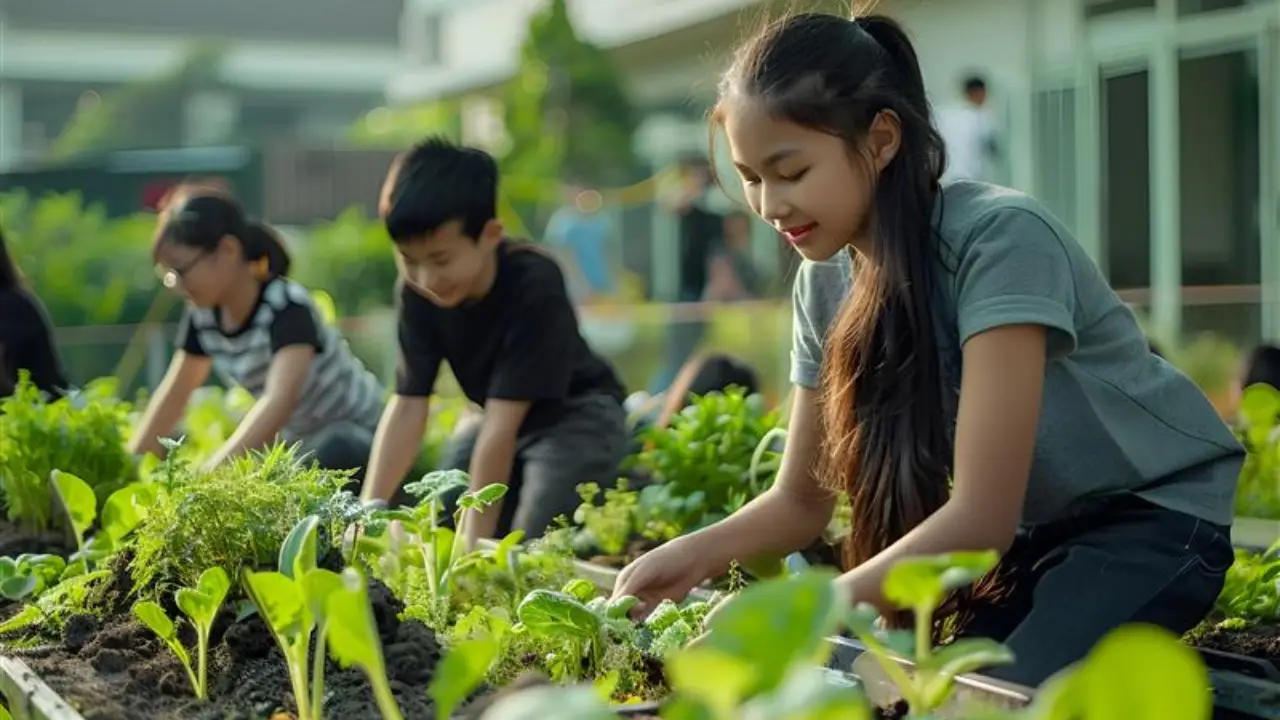
3. Becoming a Food Detective
You can keep these points in mind:
- The distance between where my rice originates and where my home is is 3,000 kilometres, and it is within local farming areas
- The sourcing of my fish remains uncertain since it could come from depleted fishing grounds or responsible marine conservation zones
- The process through which my fruit reaches me could involve natural ripening on the tree or extended storage in warehouses, affecting freshness, taste, and environmental impact.
According to WWF reports, seafood stocks show that 80% of the world’s fish reserves suffer from overfishing depletion.
Becoming a food detective means asking where, how, and by whom our food is grown, processed, and delivered. The more we understand our food’s journey, the better choices we can make for our health, environment, and future generations.
The Future of Food and Environment: What’s Next?
Technology is changing food consumption patterns worldwide, offering new ways to balance food and environment through sustainable innovations. Here are some promising innovations:
- Aeroponic system: This system proliferates vegetables without soil through air-based cultivation, vastly reducing water consumption.

- Lab-grown meat: A cruelty-free alternative with 96% lower emissions than conventional meat.
- 3D-printed food and algae snacks: The combination of 3D-printed food technologies with algae snacks marks the beginning of sustainable eating in the future.
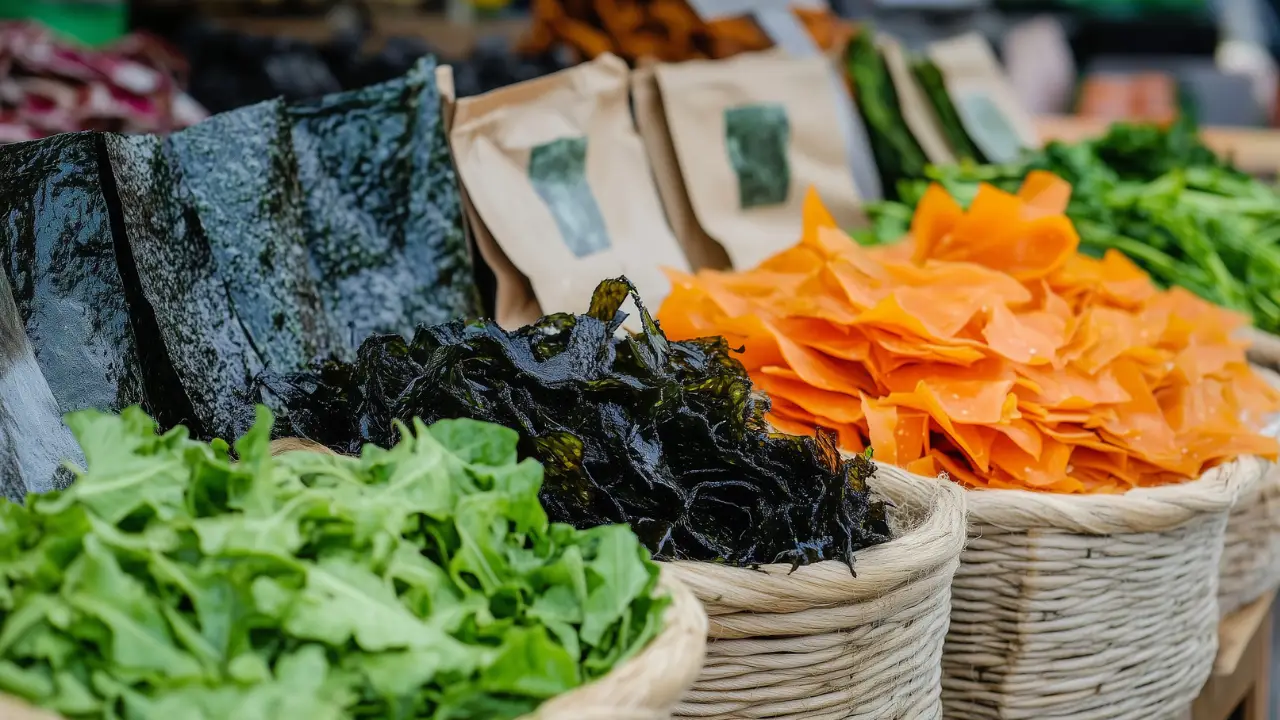
As the world’s population is projected to grow to 10 billion by 2050, it will need 70% additional food production capabilities compared to present levels. Sustainable innovations constitute a necessity because they must be prioritised.
Your Plate, Your Power
We’re often told that saving the world requires grand gestures, but what if the real revolution happens at the dinner table?
Every meal presents an opportunity to nourish your body and contribute positively to the planet. By choosing whole foods over processed options, you provide your body with essential nutrients and support sustainable food practices.
Savoring leftovers and being mindful of food waste not only respects the resources that went into producing your meal but also reduces environmental impact. The power to affect meaningful change lies within these everyday decisions may be just right on your plate.
>> Please Share



